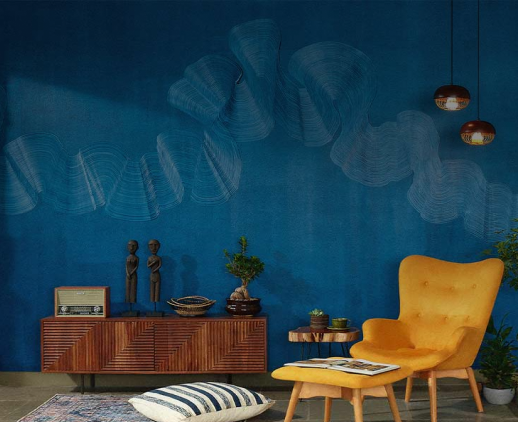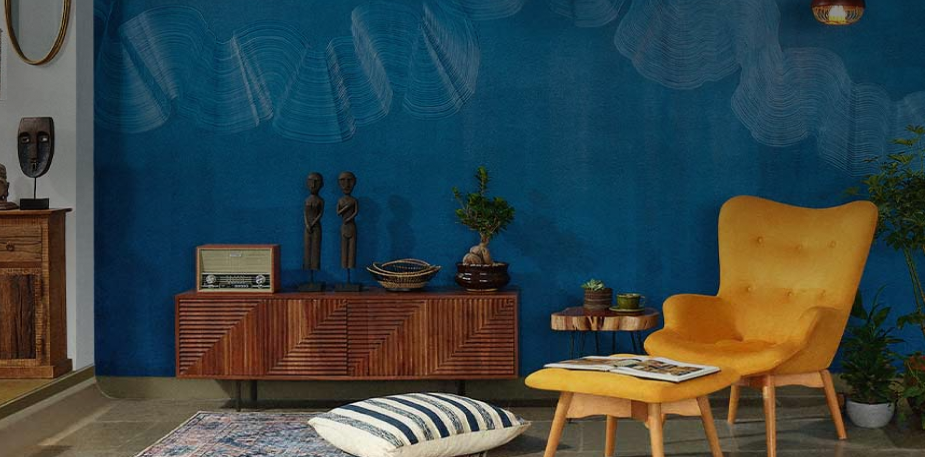Get your home interior design budget estimate
A tropical modern house in Kerala dressed in local materials and greenery

An abundance of greenery and a harmony of local materials make this inside-outside house in Thalassery, Kerala, a mosaic of colour and inventive spaces
There are many who pay lip service to the idea of sustainability. Others who look at it as the cause cèlébre to get behind in a world realizing the extent of the climate crisis. And then there are those who really just keep their heads down and do rather than speaking. Calicut-based architecture and design studio De Earth has been pretty much doing just that for almost 18 years the firm has been around. This house in a residential neighbourhood in Thalassery, Kerala, is another result of their keep it simple, keep it clean, keep it sustainable design philosophy. And Vibes is all about roots—familial, contextual, local, natural. Built on a vegetable patch on the homeowners’ parents’ plot of land, Vibes is a 3,500-square-foot, two-and-a-half storey quintessential tropical modern home.
“[As a practice] we work very closely with materials and nature and respecting the context and the culture. We don’t try to be different and whatever comes out is a natural output that is a response to the context,” says Vivek PP, co-founder of De Earth. The open-ended brief by the homeowners, Sherbeeni Shameer and Shameer Majeed, was a design that created a soulful house, rich in experience and comfort. The firm was otherwise free to interpret this rather broad vision as they saw fit, which they did by involving nature, heavily, into their plans. “We wanted to ensure openness, light and privacy.”
Naturally Inclined
Central to their design was not so much a visual and spatial connection between outdoors and indoors as much as making those boundaries so amorphous that they would seem invisible. The clever placement and use of courtyards (many of them), common to traditional tropical homes, is the route that the architects took, right from the outdoor sit-out that prefaces the entrance to the house. “Two things are always important when we design—thresholds and transitions. In this house, this elaborate sitting area with the waterbody beside it makes for a good transition space.” That leads on to the front door that opens into a voluminous living area.

The entry into the house is through the sit-out, which has leather-finish black granite stone flooring and a rattan swing; the sit-out becomes a smooth transition space, with the roof creating an intimate threshold.
“We opened up the entire space.” And quite literally too; the double-height living area “has courtyards with sliding doors on either side, bringing in the outdoors to the living area”. There is also a zen courtyard, open to wide skies with a bamboo wall along one side and accessed from the dining room. “The sloping roof extensions and the Athangudi tile flooring leading to it form another threshold space.”.
If openness is the driving force of the design, it stands to reason that nature extends vertically too, with a terrace garden on the first floor. Add in interiors crafted to let in natural light and you have a space of porous boundaries and natural embellishments. This is further served by a cleverly placed open bookshelf on the first floor, and louvred wooden shutters that let in the light.

An organic wooden breakfast counter and handpicked patterned wooden high stools provide visual access between the dining area and open kitchen.

A distressed blue wooden console is complemented by the blue oxide flooring and polished plastered walls in one of the bedrooms.
Material Play
This four-bedroom house with a mezzanine floor for the kids’ bedroom (thus accounting for the two-and-a-half storeys) is all about organic fluid movement, from apparently enclosed spaces to the natural environment. And it is all geared towards building experiences within the home, leveraging nature as completely as possible, including through the material selection. “All the materials used here are non-pretentious and local. North Kerala is famous for laterite, which is why it has been extensively used in this house.” The rather dramatic laterite facade is offset by understated Kadapa stone flooring, exposed polished plastered walls and an exposed concrete ceiling to add a rawness that makes a great canvas for what the homeowners wanted. “We wanted to make the rooms private yet playful.”
Colour Blocking
Within these broad strokes, the De Earth team painted a colourful picture of rooms, sometimes voluminous, sometimes intimate sanctuaries. “The grey wall gave us a lot of freedom to play with the colours in front of it,” says Vivek. They did so by dipping into the rich material selection at their disposal—green floral-patterned Athangudi tiles in the ground-floor bedroom downplayed with furniture in distressed wood; green-oxide-finished and wood-panelled internal staircase; blue oxide flooring in one first-floor bedroom and yellow oxide in another; even a first-floor passage of green Athangudi that adds whimsy to a passageway. The house plays up materials and plays down the furnishings in a fascinating harmony. “For the furniture, we handpicked some from different designers and custom-designed some. We also repurposed some elements for the house, like the wooden and stone pillars used around the house. We wanted to create experiences within the house,” says Vivek.
Each room within the house creates distinct impressions but they are all unified by intent, and design, pretty thresholds and seamless transitions, colour and nature. Vibes, so completely built out of nature, has the aura of tranquillity and the refreshing energy of a house that takes delight in creating an engaging experience.

Get Started with your interior design journey with us!
Speak to our design professionals
What’s the status of your home possession?
What’s the condition of your home/space?
Will you be living in your space during the renovation?
 Previous Question
Previous Question
Is your interior design budget over 4 lakhs?
 Previous Question
Previous Question
Book next available appointment slots with our experts!
Please Select Date and Day
 Previous Question
Previous Question

Something went wrong!
We were unable to receive your details. Please try submitting them again.

Appointment Scheduled!
Thank you for giving an opportunity to Asian Paints Beautiful Homes Service! Our Customer Experience Specialist will get in touch with you soon.
Appointment Date & time
Thank You!
Our team will contact you for further details.
What’s the status of your home possession?
What’s the condition of your home/space?
Will you be living in your space during the renovation ?
 Previous Question
Previous Question
Is your interior design budget over 4 lakhs?
 Previous Question
Previous Question
Book next available appointment slots with our experts!
DEC 2023
Please Select Date and Day
 Previous Question
Previous Question

Something went wrong!
We were unable to receive your details. Please try submitting them again.

Appointment Scheduled!
Thank you for giving an opportunity to Asian Paints Beautiful Homes Service! Our Customer Experience Specialist will get in touch with you soon.
Appointment Date & time
17 Oct 23, 03.00PM - 04.00PM












































